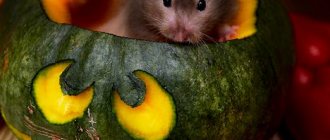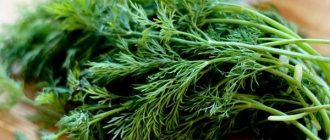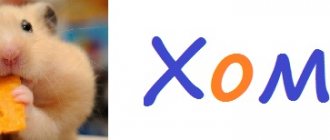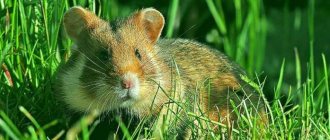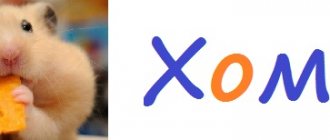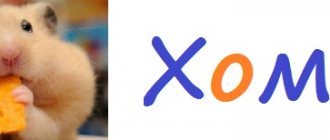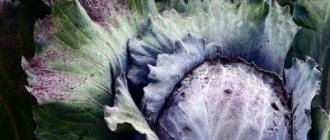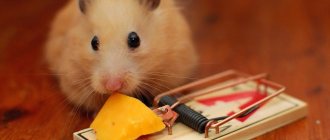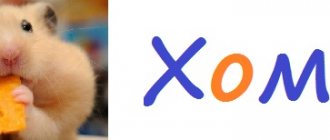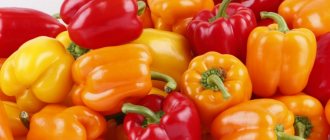Can hamsters eat cabbage? This is one of the most common questions asked by novice hamster breeders. Traditionally, this vegetable is considered healthy, rich in microelements, vitamins, and minerals. But not everything that is beneficial for humans is not detrimental to the health of hamsters. In pursuit of variety in feeding your pet, do not forget about the health of the rodent.
Features of a hamster's diet
A fluffy rodent will happily eat whatever is offered to it, but you should not feed it what the owners themselves eat. Such food will lead to the development of gastric diseases and death of the pet. When creating a menu for your hamster, you should focus on what it eats in the wild. The basis of this diet is cereals, green leaves, herbs, and vegetables.
Hamsters get protein by eating beetles, worms and caterpillars.
These animals have an accelerated metabolism, so they cannot tolerate even short periods of fasting. This forces them to hide some of the food, stocking up for future use. You will have to regularly inspect the animal’s cage in order to remove perishable foods in a timely manner and replace them with fresh ones. Fruits, herbs and vegetables are added little by little as complementary foods, so as not to provoke bloating in the pet.
How to pamper the dzhungarik?
Hamsters will happily crunch on carrots, bell peppers or fresh cucumbers. You can treat them with fresh or dried corn, dandelion leaves or parsley. Fortunately, the list of vegetable crops and herbs for hamsters is very large and can easily provide adequate nutrition and a set of necessary vitamins for the active functioning of the creature.
This is a vegetable that you can’t do without in the kitchen. Since almost everyone has it, and rodent owners often feed them everything they have at home. The question arises, is it possible to give cabbage to hamsters? An interesting question in that it is controversial. On the Internet, opinions in this regard are very divided. Some say it’s possible, others say it’s possible in moderation, while others say it causes farts and bloating in the rodent. Who to believe? Today we will finally figure it out and give the answer.
Opinions on the benefits of cabbage for hamsters
There is no consensus on feeding cabbage to domestic rodents. Some experts consider the product dangerous to health, while others argue that it should be regularly included in the diet.
Basic feeding rules:
- You can buy cabbage only in season, from August to November. During this period it contains the most vitamins.
- It is not advisable to serve white cabbage and Brussels sprouts raw.
- The permitted amount is no more than 50 g twice a week.
In addition to vegetables and fruits, the hamster needs fresh herbs, such as clover, plantain, dill, and burdock. Once a week, the menu includes young branches of oak, apple, birch, and cherry.
What cabbage can and cannot be given to hamsters
Cabbage contains a large amount of vitamins, proteins, microelements and carbohydrates. This is an irreplaceable source of fiber that is beneficial for the body of rodents.
White cabbage
This type of cabbage is rich in ascorbic acid, which means you should definitely offer the vegetable to the animal. He eats only the leaves, without the stalk. Young animals are allowed to be given 50 g of raw white cabbage 2-3 times a week, but for older animals it is better to boil it and grind it into a paste. Some owners believe that this vegetable in its raw form is dangerous for rodents, but it all depends on the breed, age and health of the pet.
Brussels
An excellent source of protein and many useful elements that are completely absorbed by the body. It is prohibited to give Brussels sprouts to pregnant and lactating females, as it provokes premature birth and problems with lactation. It is also contraindicated for hamsters suffering from stomach diseases due to its strong laxative effect.
The vitamins contained in Brussels sprouts are beneficial for the rodent's body, because they are easily absorbed.
Colored
Due to the high content of ascorbic acid and vitamin A, this vegetable helps improve immunity and strengthen bone tissue. It must be included in the diet both raw and boiled. To preserve the beneficial properties of the product, it is not cooked for long. It is enough to put it in boiling water for 1-2 minutes, cool it and give it to the hamster, but not more than 40-50 g.
Cauliflower is useful for animals of any age and breed.
Beijing
This variety contains a large amount of water and minerals, which helps cleanse the animal's body of toxins. It is recommended to give it to the animal weekly and only in raw form.
Broccoli
The product contains vitamins C, groups B, A, D and K, fiber, protein and a mineral complex. Suitable for dietary nutrition for obesity, increases the body's defenses.
Red cabbage
Red cabbage is strictly contraindicated for hamsters. It contains a lot of heavy fiber, which is poorly digested and leads to an imbalance in the intestines.
Red cabbage is strictly prohibited for the diet of hamsters.
The consequences of eating red cabbage for hamsters:
- bloating;
- intestinal dysfunction;
- stomach diseases;
- severe pathologies leading to death.
The vegetable is not absorbed by the body and can lead to health problems.
White cabbage
When asked whether hamsters can have white cabbage, experts give an unequivocal answer - of course it is possible and even necessary. This product contains a large amount of vitamin C and other beneficial substances that a small animal’s body needs.
In addition, hamsters eat white cabbage with great pleasure. It is juicy, sweet and crispy.
But there is one caveat! It is not recommended to give your hamster cabbage of this variety too often. There must be moderation in everything. Excessive consumption of this vegetable can negatively affect your pet's health. Cases of overeating were often observed, resulting in rodents experiencing diarrhea and vomiting.
A vegetable familiar to humans becomes the source of much controversy when it comes to the nutrition of rodents. The obvious benefit is expressed in a large number of vitamins, but there is an opinion that flatulence and disturbances in the functioning of the digestive system can be provoked.
You definitely shouldn’t give Djungarian and Syrian hamsters raw cabbage. This requirement applies to other breeds as well. You can occasionally pamper your pet with a piece of boiled leaf, but you need to closely monitor its condition and behavior.
In what form is it best to give?
Raw cabbage contains more vitamins than boiled cabbage, and the hamster's nutrition should be balanced and complete. Young, healthy animals can eat uncooked vegetables. Sick and elderly pets should be given boiled and ground. For gastrointestinal diseases, cabbage is given with caution, in limited quantities, no more than 20-30 g once a week.
Boiled cabbage will be useful for sick and elderly rodents.
Feeding rules
Hamsters are nocturnal animals, so they need to be fed 2 times a day: in the evening and in the morning. The evening meal should be more dense, because for the animal it is considered breakfast. The diet is based on ready-made grain mixtures, and the serving size depends on the weight of the pet. Large rodents will need 1 tbsp for 1 feeding. l. dry food, and for dwarf breeds 1 tsp is enough.
Vegetables, berries and fruits are given as treats and do not replace the main food. The cage must have clean drinking water, which is changed daily. It is better to buy a closed drinking bowl for your hamster that cannot be knocked over.
Features for different breeds
Any cabbage (except red cabbage) should be present in a hamster's diet, but in limited quantities. The animal eats mainly cereals and cereals, and boiled chicken meat or low-fat cottage cheese can be used as a source of protein. Some breeds have their own characteristics that should be taken into account.
Dzungarian
This is a small animal, prone to obesity, and unpretentious in food. He needs a balanced diet, and of all types of cabbage, broccoli is best suited.
Broccoli is the best type of cabbage for the Djungarian hamster.
You can give it every other day, no more than 25 g at a time. The daily menu should include: dry grain food, mineral stones, tree branches, nuts, pumpkin seeds.
Syrian
Large, the size of a man's palm, the hamster is golden sand in color. The basis of its diet is grains, cereals, herbs and vegetables. It is better to give boiled cabbage and no more than 2 times a week.
It is recommended to buy ready-made dry food, and beets, cucumbers, carrots, bell peppers, pumpkin and zucchini are suitable as complementary foods.
Dwarf
The Roborovsky hamster (dwarf) is small in size, and its weight is no more than 25 g. It is not advisable to add cabbage to the rodent’s menu in any form, but you can feed it with a grain mixture, leaves, and wheat sprouts. Eggs, cottage cheese and fish are suitable sources of protein.
Wild forest
In nature, a wild hamster feeds mainly on plant foods, but is not averse to eating insects, small reptiles and rodents. He prefers buckwheat, millet, lentils, peas, and among vegetables he eats carrots and potatoes. Due to increased aggressiveness, it is not suitable for keeping at home.
How can a Chinese vegetable be dangerous for animals?
Of course, everything is good in moderation. Therefore, when introducing cabbage into your pet’s diet, you must remember that an excessive dosage can be harmful.
When choosing a cabbage product, you need to make sure it is fresh. Thus, stale leaves can cause damage to the health of the animal.
If the cabbage was purchased or cut a long time ago, or is stored in inappropriate conditions, then it is better to immediately abandon the idea of feeding it to your pets. There will definitely be no benefit from this, and irreparable harm can be caused.
Do not use limp or darkened leaves to prepare food. Make sure that there are no different types of larvae on the surface.
Experienced animal breeders recommend removing the veins from the leaves of Chinese cabbage to make it easier to digest and also to prevent the ingress of nitrates. Nitrates tend to accumulate in the hard tissues of the vegetable.
A hamster's diet must contain greens. One suitable option is Chinese cabbage. It contains many useful elements that are vital for a hamster. This will help strengthen the animal’s immune system, giving it strength and vigor. It will also maintain the required fluid level.
What else can and cannot be given to a hamster?
Small hamsters left without a mother must be fed with a special formula for newborns. It is diluted with boiled water and fed to the animals using a pipette every 2 hours.
Lactating females will need more protein food, and adult animals are given dry food and vitamin supplements.
Tangerines and oranges
Any citrus fruits are contraindicated for hamsters. This is due to the high content of organic acids in fruits, which destroy tooth enamel and irritate the gastric mucosa. In addition, large amounts of vitamin C contribute to the development of allergies and hypervitaminosis.
Pomegranate
The list of prohibited foods also includes pomegranate, which contains a lot of tannins that cause constipation. Alkaloids, essential oils and acids provoke indigestion, allergies, and intoxication of the body.
Mango
It is undesirable to feed hamsters exotic fruits, but there is no strict ban on mangoes. You need to start complementary feeding with a small piece, and if the animal’s behavior has not changed or a rash has appeared, then the product can be added to the diet.
Mango can be included in your hamster's diet.
Apples
This seasonal product is recommended to be used as a treat, given in small portions and infrequently. Apples contain many vitamins and minerals that strengthen the immune system and renew the composition of the blood. The fruit should not be offered to pregnant females or elderly individuals.
Bananas
There is no categorical ban on these exotic fruits for hamsters, but care must be taken to ensure that the animal does not hide the treat in reserve. Bananas quickly spoil, and this is fraught with poisoning. Banana pulp may stick to the larynx and cause difficulty breathing. In this case, it is better to give the animal dried bananas (no more than once a week).
Avocado
Avocados are also on the long list of prohibited foods. The danger is posed not only by the high-calorie pulp of the fruit, which causes allergies, but also by the seed, which contains toxic substances.
Dried apricots
Hamsters are prone to obesity and diabetes, and dried fruits contain a lot of sugar. A couple of times a week you can give the animal half a dried apricot, but no more.
Dried apricots should be present in small quantities in a hamster's diet.
Nuts
The menu should include any nuts except almonds, acorns and Brazil nuts. The treat should be offered in its purified form and no more than 3 times a week. These are high-calorie foods, and you shouldn’t get carried away with them.
Corn
It is an essential source of protein and amino acids necessary for the growth and development of the body. It can be given boiled or raw, without salt or sugar. Canned corn is prohibited, as are corn sticks.
bell pepper
Sweet peppers are permitted products that are used as a treat. It can be given in small portions three times a week.
Radish
Due to its high folic acid content, radishes are beneficial for pregnant females. The vegetable cleanses the liver, speeds up metabolism, and improves blood circulation. It should be given to hamsters regularly, but in small quantities.
Radishes can be given to rodents, because they contain many useful substances, vitamins and microelements.
Onion
Neither onions nor green onions are given to hamsters: they contain a lot of essential oils with a pungent taste and smell.
Tomatoes
Syrian hamsters are prone to developing arthritis, so tomatoes in any form are contraindicated for them. This ban does not apply to Dzungarians. It is better to give tomatoes fresh, without skin, grown in your own garden. Animals should not be fed canned, dried or green vegetables.
Carrot
Vitamin-rich carrots are indispensable for a complete, balanced diet. It is included in the diet every day, for breakfast (1 circle no more than 1 cm thick is enough). The treat is pre-cleaned, washed and soaked in water for 2-3 hours.
Beet
It has a strong laxative effect, so it is given to hamsters in small quantities once a week. A small piece of raw beets is suitable as a treat.
Raw and boiled potatoes
A couple of times a month you can give the animal some raw potatoes to sharpen its teeth. Boiled root vegetables are contraindicated because they contain a lot of starch, which provokes the development of obesity.
Raw potatoes are a natural food for hamsters.
Sausage
Any sausage product will be harmful to the rodent’s body, because, in addition to meat, it contains harmful preservatives, flavors and spices. Such food is harmful to a hamster's sensitive stomach.
Cheese
Hard cheese with low fat content is allowed in small quantities.
Twice a week you can offer your hamster a small piece (about the size of a sunflower seed).
Boiled buckwheat
The animals happily eat both raw buckwheat and porridge. There is no harm from this product if it is prepared correctly. During heat treatment, cereal loses many useful substances, so it is better not to cook it, but simply pour water over it overnight.
Bread
Fresh baked goods should not be given to hamsters, but rye crackers as a treat will not do any harm. There is no need to buy ready-made crackers; it is better to dry the bread yourself.
Rye crackers contain a number of microelements necessary for the hamster’s body.
Sweets
Chocolate, honey and other sweets are deadly for hamsters.
Even a small candy can lead to fatal poisoning.
Milk
Boiled milk diluted with water can be given to females during lactation, but not more than 2 times a week. The product is contraindicated for other individuals.
Dandelions
The stems of the plant contain poisonous milky sap, so the animals only need to be given leaves and roots. They are rich in nutrients that improve digestion.
It is recommended to give hamsters leaves and roots of dandelion.
Brussels
Different types of cabbage have different effects
Do hamsters eat this type of cabbage? With great pleasure! This vegetable is a real storehouse of vitamins and minerals. In addition, it contains a large amount of protein, which pet rodents so need.
Therefore, experts strongly recommend giving your hamster this type of cabbage. Regular consumption of such a product in food helps to normalize the functioning of the digestive system. In addition, such a product with a high content of vitamin C increases the rodent’s immunity against various diseases.
Article on the topic: What to feed a Syrian hamster at home, what can be given and what cannot be given
Hamsters eat this variety of cabbage especially well in the off-season, when all varieties are gone, and this type is sold on store shelves.
